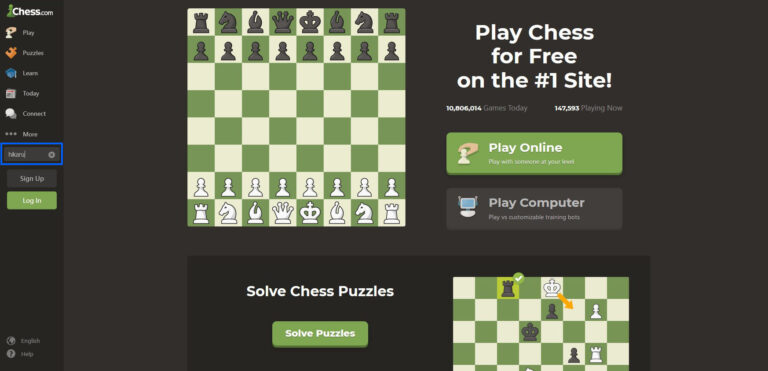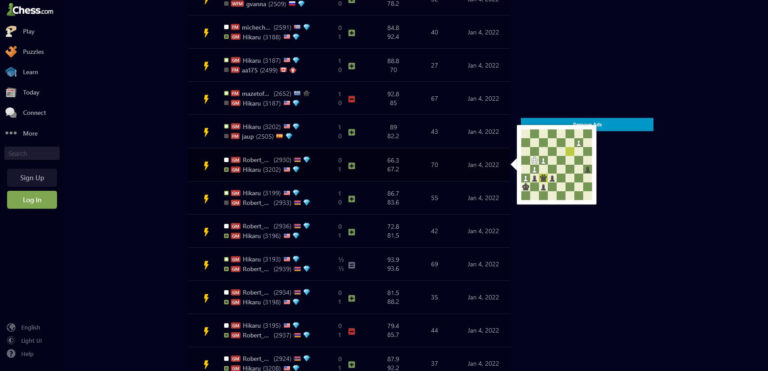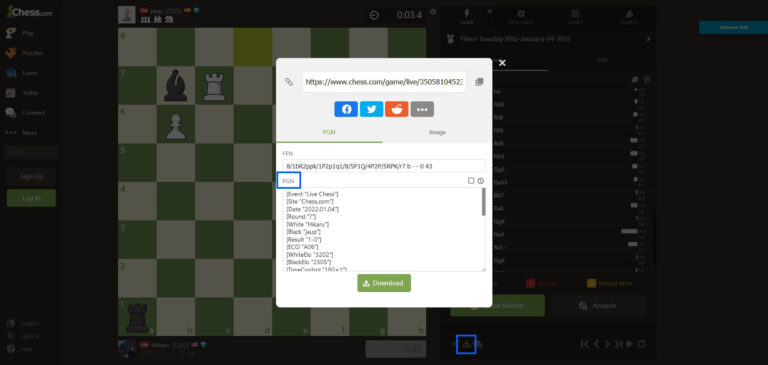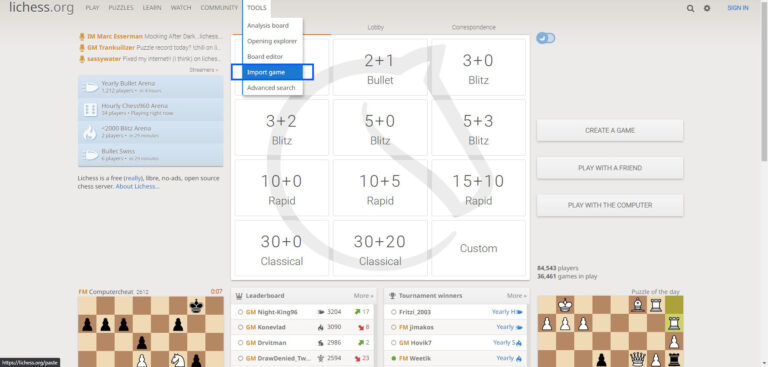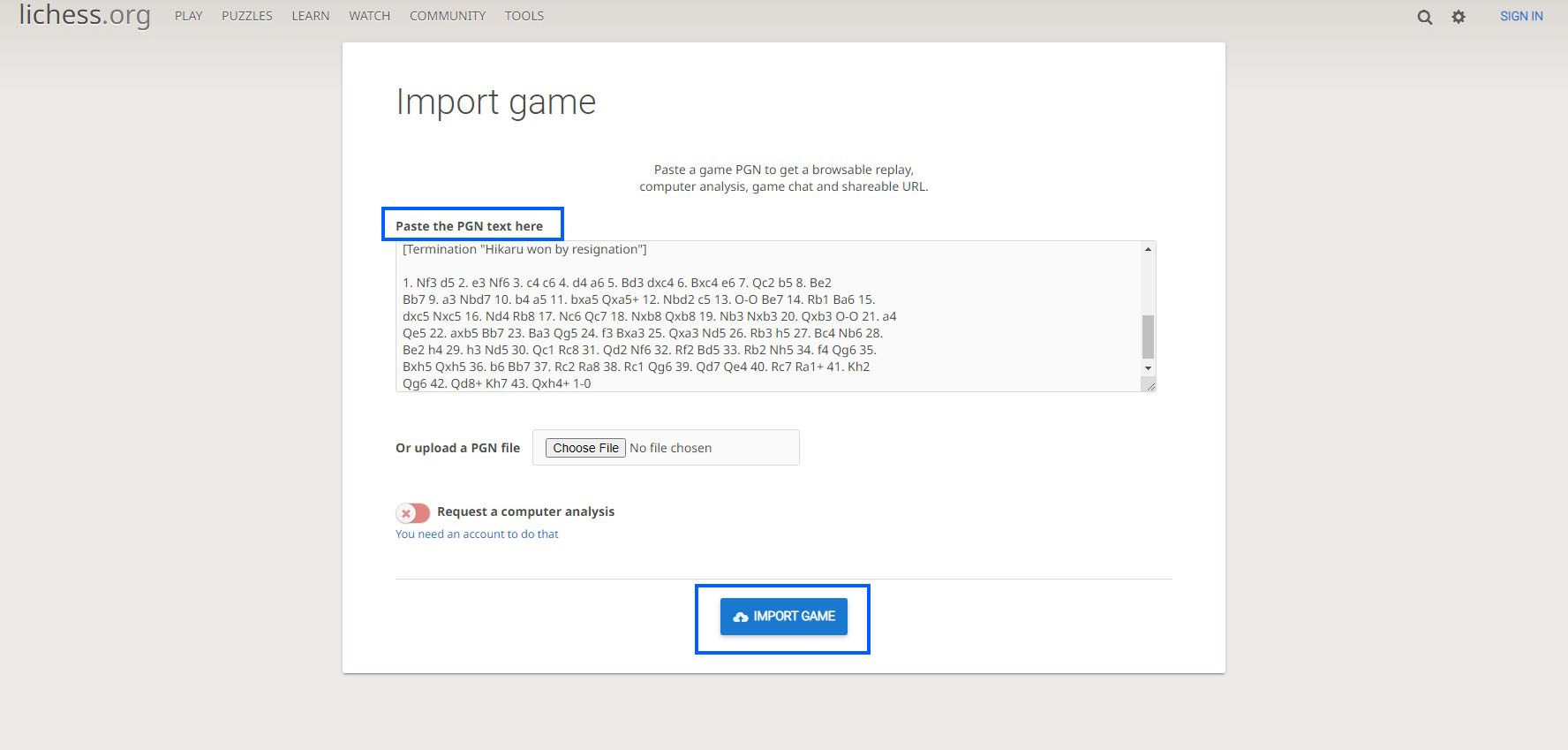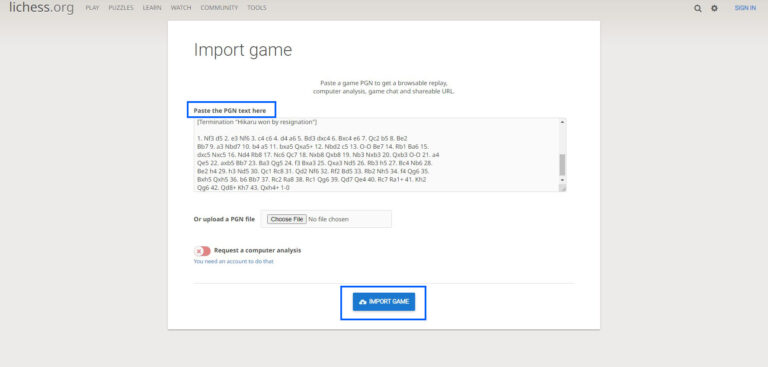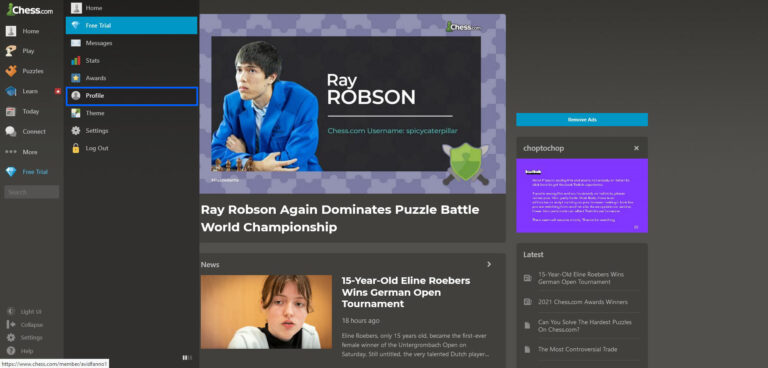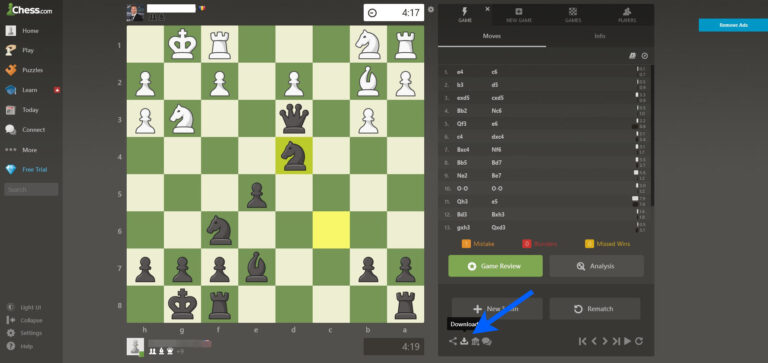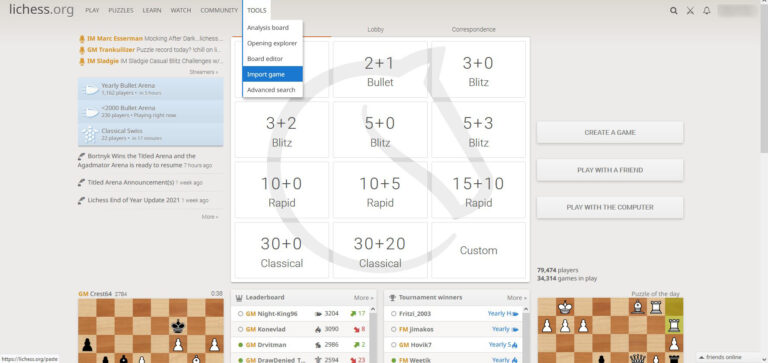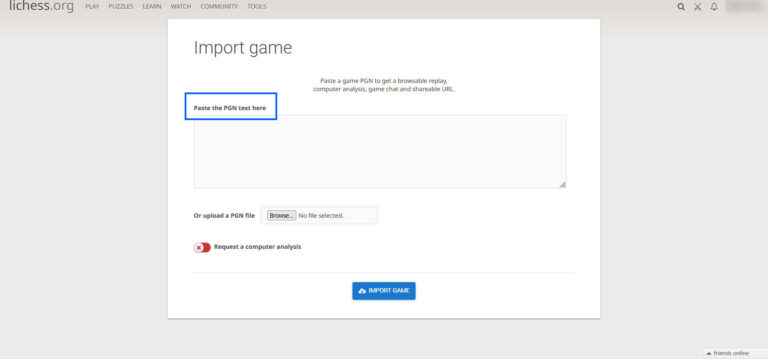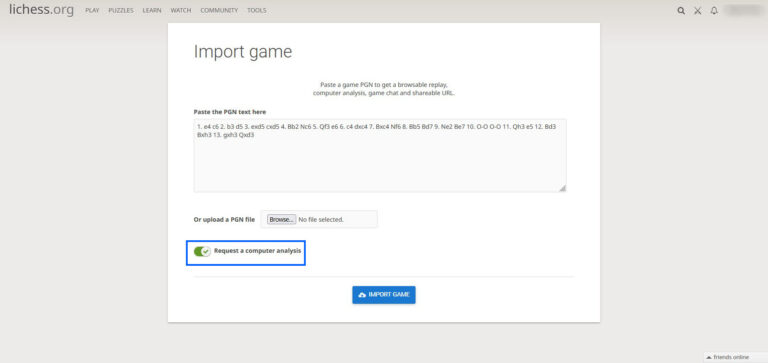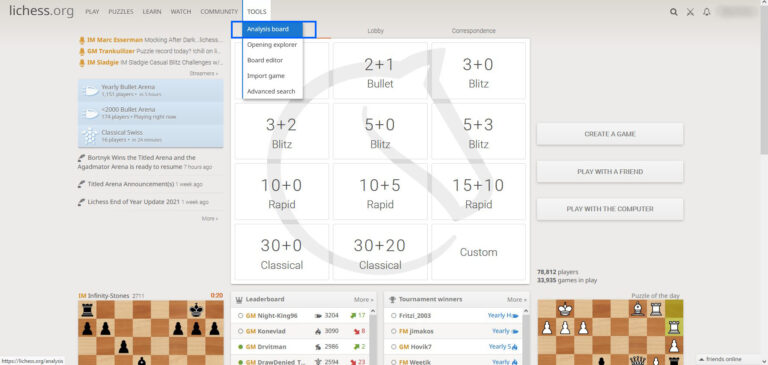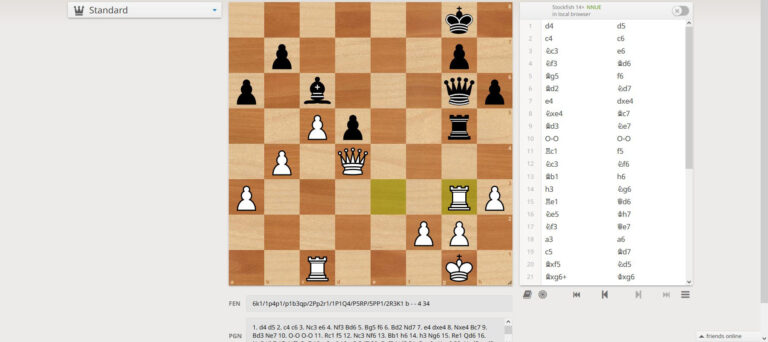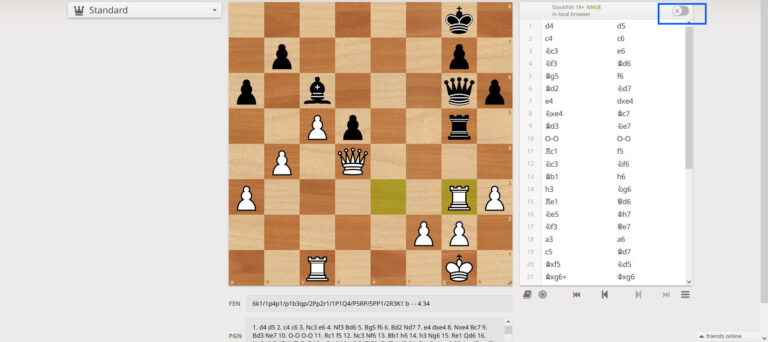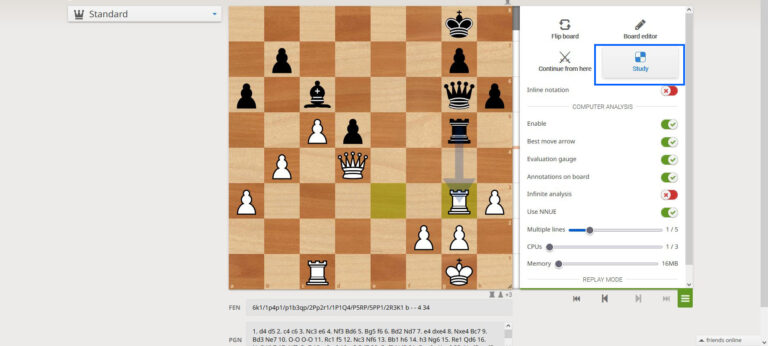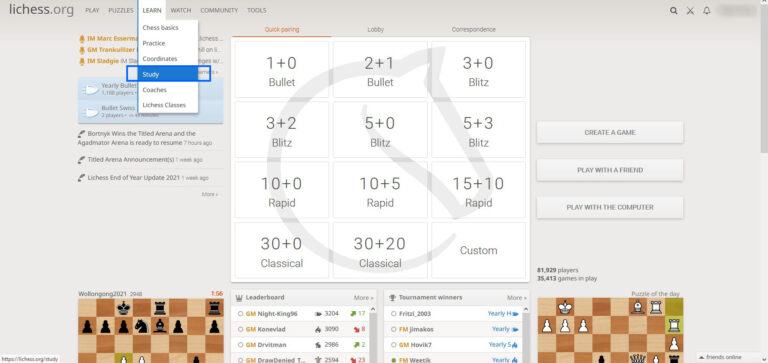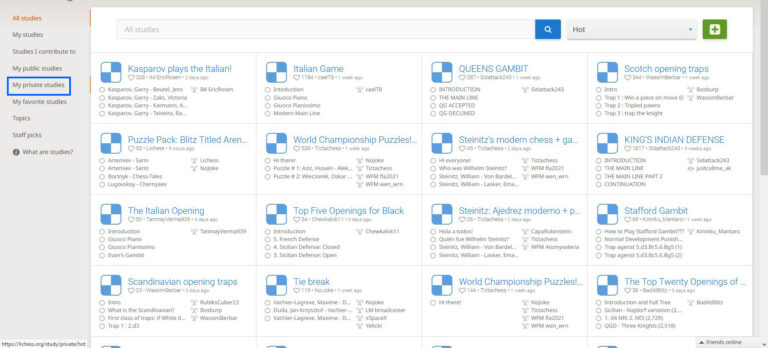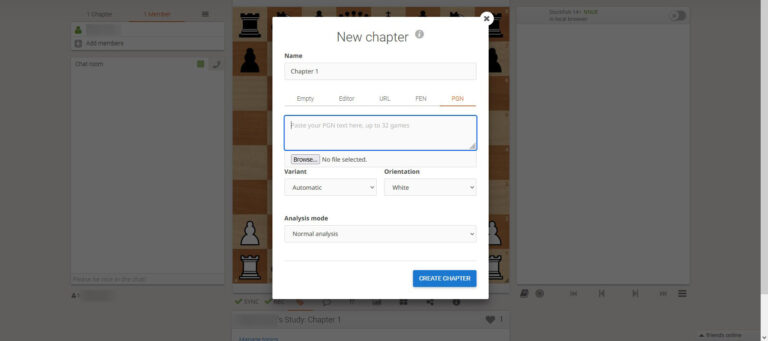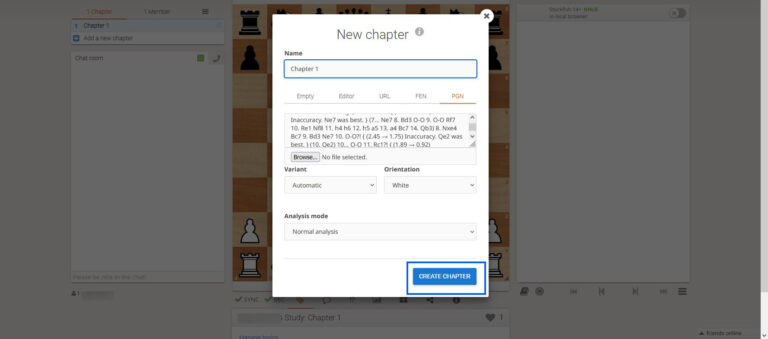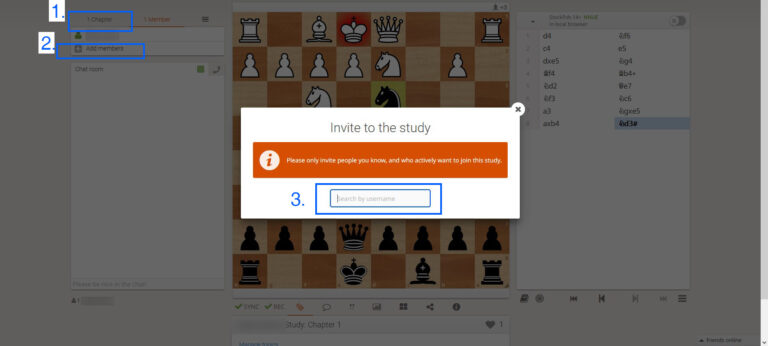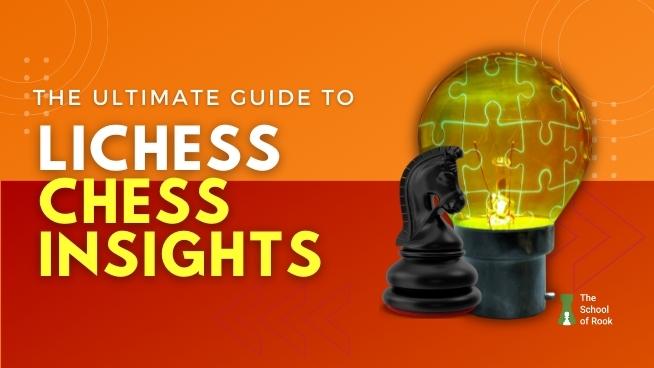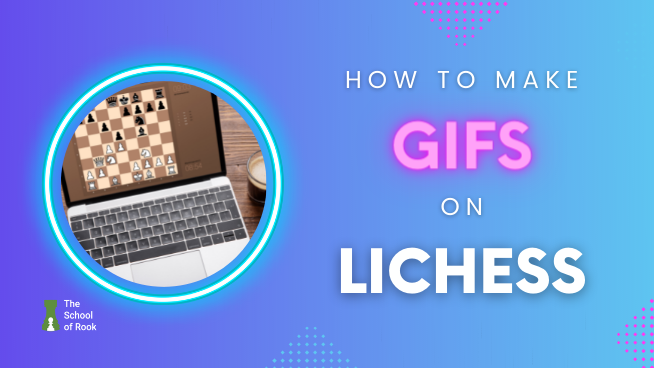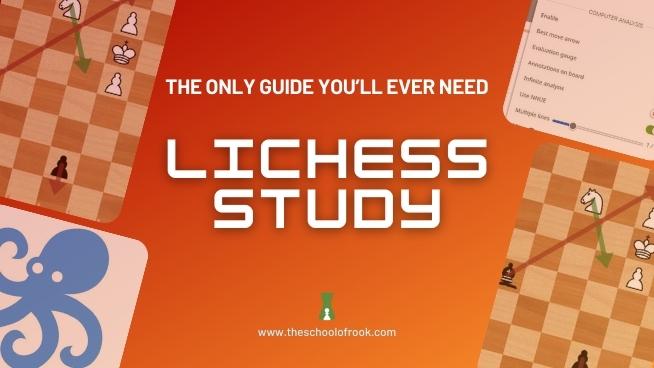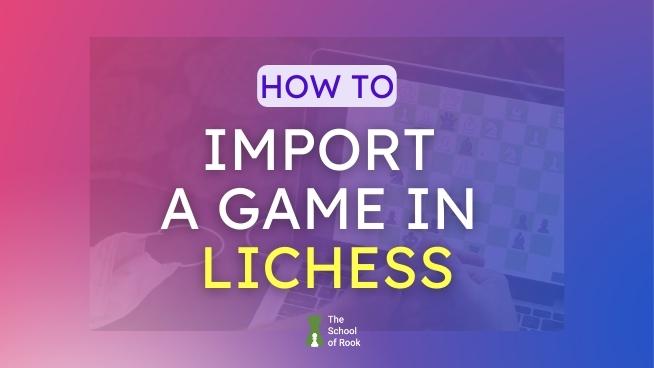
If you play chess regularly, you probably know that analyzing your games is a crucial way to improve your skills.
Lichess makes it easy for you to import your games. You get to see your mistakes and the tactics you’ve missed and analyze your game.
Lichess uses Stockfish 14+, arguably the strongest chess engine globally, to analyze chess games. Stockfish 14 and above versions have an Elo rating of 3500+, a good 600 to 700 points ahead of Magnus Carlsen.
So you know that the analysis will be top-notch. And the best part about importing a game to Lichess is that you don’t need a Lichess account to use this advanced feature.
So let’s dive right into how to import a game in Lichess!
Terms to know how to import a game in Lichess
The three terms you should know to import a game in Lichess are PGN, FEN, and Stockfish NNUE.
PGN
PGN, or Portable Game Notation, is a way to record chess games in plain text format. The moves are written in Algebraic Chess Notation.
Here’s an example of Scholar’s Mate in PGN format:
1. e4 e5 2. Qh5 Nc6 3. Bc4 Nf6 4. Qxf7#As you can see, the moves are easy to read and write. These moves are auto-generated and can be imported or exported.
Let’s look at another PGN example:
[Event “World Chess Championship Karpov vs Kasparov 1985”]
[Site “”]
[Date "2021.08.24"]
[Round “?”]
[White “Garry Kasparov”]
[Black “Anatoly Karpov”]
[Result “1/2-1/2”]
1. e4 e5 2. Nf3 Nf6 3. Nxe5 d6 4. Nf3 Nxe4 5. d4 d5 6. Bd3 Nc6 7. O-O Bg4 8. c4
Nf6 9. Nc3 Bxf3 10. Qxf3 Nxd4 11. Re1+ Be7 12. Qd1 Ne6 13. cxd5 Nxd5 14. Bb5+ c6
15. Nxd5 cxb5 16. Qb3 O-O 17. Nxe7+ Qxe7 18. Qxb5 a6 19. Qb3 Rfd8 20. Be3 Rac8
21. Rac1 h6 22. h3 Nd4 23. Bxd4 Rxc1 24. Rxc1 Rxd4 25. Qc2 Qe4 26. Qxe4 Rxe4 27.
Rc7 Re1+ 28. Kh2 b5 1/2-½
There are seven lines of text in between square brackets ([]) before the moves. These seven pairs are called Seven Tag Roster and are required to store a game in the archive.
FEN
FEN, or Forsyth-Edwards Notation, is a way to record a specific chess position.
This type of notation does not describe the moves leading up to the position. So you don’t know how the position developed.
Here’s an example of the end position of Scholar’s Mate in FEN format:
r1bqkb1r/pppp1Qpp/2n2n2/4p3/2B1P3/8/PPPP1PPP/RNB1K1NR b KQkq - 0 4
The moves aren’t easy to write or read compared to the PGN format. But that doesn’t mean the PGN format is superior to the FEN format.
With the FEN format, you can recreate a chess position with only a single line of text. So it’s beneficial to import puzzles or play a game from that particular position.
Let’s look at another FEN example:
8/8/4R1p1/2k3p1/1p4P1/1P1b1P2/3K1n2/8 b - - 2 43
There are six fields separated by a forward slash (/). Each piece is denoted by its letter. Uppercase letters describe the White pieces, while the lowercase letters describe the Black pieces.
Stockfish NNUE
Stockfish is an open-source chess engine known for its powerful and robust CPU. NNUE, an abbreviation of Efficiently Updateable Neural Network, essentially calculates scores for each move.
Stockfish and NNUE were forked together, and the result was much stronger than the regular Stockfish engine. Thus, Stockfish NNUE was born.
Currently, Lichess has been using the Stockfish 14.1 engine since October 2021.
Now that we know what PGN, FEN, and Stockfish NNUE mean, let’s import games to Lichess.
How to import games from Chess.com to Lichess
There are two ways to import a game from Chess.com to Lichess:
- Without an account
- With an account
How to import a game from Chess.com to Lichess without logging in
- Go to Chess.com and type in the username in the search box, which is located on the left side of your screen. Press “Enter.”
- You’ll see your profile in the “Search Results.” Click on the profile to continue.
- Search for the game and click on it to go to the game.
- You’ll find a download icon between the share and comment icon on the bottom right side. Click on the download icon and copy the PGN data.
- Go to “Lichess” > “Tools” > “Import game.”
- Now paste the PGN data in the “Paste the PGN text here” text here. Click on “Import Game.”
Note:
You’ll have to log into your Lichess account to request a computer analysis.
That’s it! Now you’ve successfully imported a game from Chess.com to Lichess.
How to import a game from Chess.com to Lichess after logging in
- Go to “Home” > “Profile” once you’ve logged in to your Chess.com account.
- Next, click on the “Games” section located beside the “Notes” section. Then click on the desired game you wish to analyze.

- You’ll find a download icon between the share and library icon on the bottom right side. Click on the download icon.
- Copy the PGN data, go to Lichess, and log in to your account. Then, go to “Tools” > “Import game.”
Note:
You can also download the PGN file and upload it directly on Lichess.
- Now paste the PGN data in the “Paste the PGN text here” text here.
- Click on the toggle button to request a computer analysis. Finally, click on “Import Game.”
Note:
All chess websites have the option to download, copy, or export PGN files of the game. The method to import a PGN file to Lichess remains the same irrespective of the source.
How to import an OTB game to Lichess
Importing an OTB (over the board) game to Lichess is pretty straightforward, albeit lengthy.
Follow these steps to import an OTB game to Lichess.
- Go to “Tools” > “Analysis board.”
- Play the moves. You can also add notes for each move or create variations in the game.
- Make sure the toggle located on the top right corner is enabled. You’ll see Stockfish analysis on the left side of your screen.
- To save the analysis, you can make a Study by going to “Menu” (bottom right of your screen) > “Study” > either “Create study” or add to existing “My studies.”
How to import multiple games to Lichess
You can import up to 32 games on Lichess. You
- Login to your Lichess account and go to “Learn” > “Study.”
- Select “My private studies.” You can either create a new study by clicking the green plus icon on the top right side or add the games to an existing study.
- Once you’re in the Study, click on “Add a new chapter.”
- Go to the PGN section. There are two ways to paste your games here:
i) You can individually paste PGN files of each game. Make sure you separate each game with an empty line. Otherwise, you’ll get an error “Cannot parse moves: [6.1] failure: end of input expected:” and only the first game will be added to the chapter.
ii) You can directly upload a file with 32 games. Make sure the file is saved in a .pgn format.
Note:
You can only add up to 32 games in a single go. You can repeat the process and add another 32 games in the same study as long as the number of chapters doesn’t extend beyond 64.
- Click on “Create Chapter.”
All the games are now added to your Lichess Study. You can click on the evaluation toggle located on the top right-hand side to enable computer analysis.
How to share imported games
To share imported games, you’ll first need to add games to “My studies.” Follow these steps to know how to share imported games:
- Add games in the form of chapters to your private study. If you don’t know how, follow How to Import Multiple Games to Lichess section above.
- Then, go to the Members section, which is located on the top left side of your screen.
- Add the Lichess username of the person you want to share your games with.
That’s all! You can share imported games privately with your friends or coach with ease.
What’s after importing a game to Lichess?
Importing a game to Lichess is the first step in starting your game evaluation. You can then use the Computer Analysis tool in the Lichess Analysis Board to help with your assessment.
Lichess also has a feature that lets you create GIFs of a game. You can then share it with your coach, friends, or social media.
Now, go on and make the best use of this free feature!

